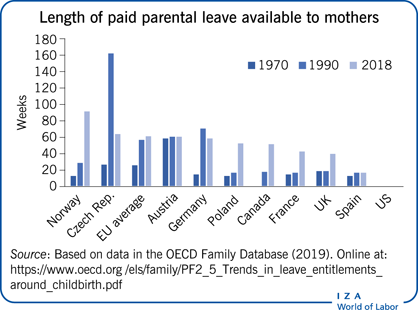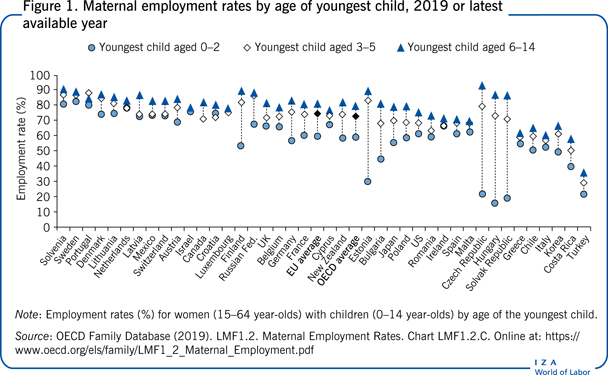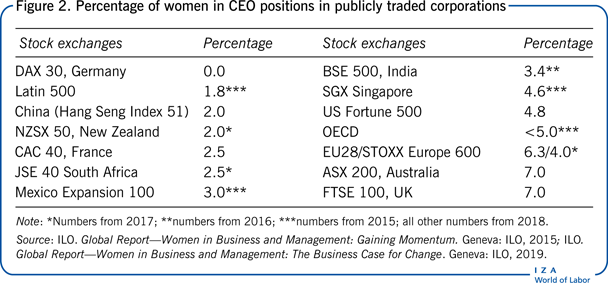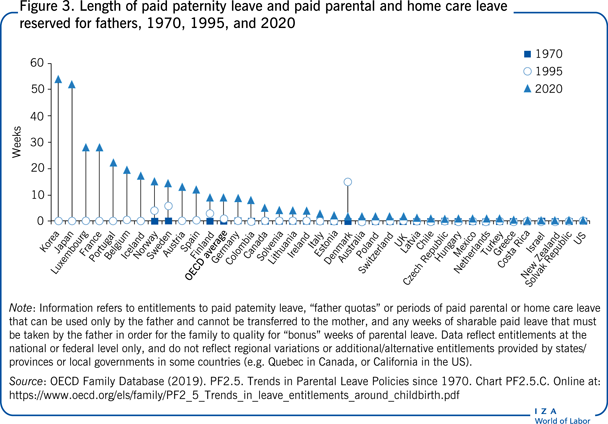Elevator pitch
Numerous studies have investigated whether the provision and generosity of parental leave affects the employment and career prospects of women. Parental leave systems typically provide either short unpaid leave mandated by the firm, as in the US, or more generous and universal leave mandated by the government, as in Canada and several European countries. Key economic policy questions include whether, at the macro level, female employment rates have increased due to parental leave policies; and, at the micro level, whether the probability of returning to work and career prospects have increased for mothers after childbirth.

Key findings
Pros
Parental leave increases the family–work balance.
Workers are protected from losing their jobs due to parental leave policies.
Workers’ and firms’ investment in firm-specific human capital is protected through job-protected leave.
The likelihood that workers return to the same employer after parental leave is higher if the leave period is not too long (i.e. not more than one year).
The introduction of parental leave quotas for fathers has helped create incentives for employers to grant paternal leave, and for fathers to take it.
Cons
There is some evidence that entitlement to prolonged leave longer than one year negatively affects employment rates and careers.
Career interruptions due to parental leave can lead to detachment from work and human capital depreciation, especially with longer leave durations.
Losses in terms of wages and human capital depreciation from parental leave are higher for highly educated than for low or medium educated parents.
Evidence of discrimination against women and mothers in some areas of work exists; parental leave policies represent one potential explanatory factor.
Author's main message
Parental leave schemes provide policy options to increase maternal employment and improve the work–family balance. International experience, mainly from Europe, shows positive experience with short and medium leave periods. Nevertheless, there are career costs related to parental leave. As such, governments and firms should take notice of workers’ career costs, which vary by educational level and increase according to the length of leave. Public policy and firm-based practices such as return-to-work mentoring programs should be established in order to reduce the costs associated with periods of leave and to provide incentives to return to work early.
Motivation
Two significant challenges firms encounter are how to recruit the best workers and how to maintain human capital within the firm. In many countries, women with children fall behind comparable men in terms of career prospects and wages. Part of the reason for this achievement gap is that a large proportion of women do not return to work soon after childbirth.
International data on employment rates used to show that women with children were much less likely to be employed than women without children. This picture has changed and the group of mothers significantly less likely to be employed is those with very young children, below the age of three (Figure 1). Employment rates for mothers are also relatively low for those with low education, and with a migration background (see OECD Family Database).

Parental leave policies are generally regarded as important tools to increase maternal employment and the work–family balance, that is, the time spent by parents with their family versus time spent at work.
Globally, women are still performing worse than men on the “career ladder.” Quite pronounced is the underrepresentation of women in CEO positions throughout most countries (Figure 2). However, it is not just at the top echelon of corporations where women are underrepresented. This phenomenon is also seen in higher- and medium-level management positions as well as top academic positions.

The overall impact of parental leave policies on maternal employment has been thoroughly investigated in country studies that use panel data at the individual level as well as international panel data at the aggregate country level. However, testing theoretical predictions and interpreting empirical evidence is challenging because it is very difficult to trace the direct or causal effects of parental policies on maternal labor market outcomes.
Discussion of pros and cons
What are the expected theoretical employment effects of parental leave?
From the starting point of a macroeconomic theoretical perspective, parental leave policy is likely to increase the labor supply if those groups that are most likely to have children and to take such leave are eligible to parental leave and return to work. This is because the cost of having children and the opportunity cost of work are decreased. (It could also have a positive effect on the likelihood of having children.) At the same time, labor demand may decrease, but only in the case where parental leave is costly to employers. In Europe, where parental leave is publicly funded, labor demand effects are arguably quite small, and the net effect of parental leave on female employment rates is expected to be positive.
Proponents of parental leave stress that under most parental leave schemes the person benefitting has to have a job prior to giving birth in order to be eligible for job protection and benefits. The guarantee that the new parent cannot be fired by the employer during protected leave and will be able to return to their previous job increases the job prospects of women who leave work after childbirth under the auspices of parental leave schemes. These arguments can be used as a basis to expect positive overall effects on maternal and female employment as a result of these schemes. Again, from a theoretical perspective, it is expected that job-protected leave leads to an increase in mothers’ return to work rates after childbirth. The longer the eligible leave period is, the higher the expected return rate, as women who wish to take long leaves because of a desire to stay longer with their child can now return later to their previous employer. The right to work part-time during parental leave should also have additional positive effects on maternal employment rates.
One factor that may work toward a relative decrease in maternal employment is that parental leave encourages some working women to stay out of the labor force for longer periods after childbirth than they would otherwise have done. This may result in (increased) depreciation of human capital and detachment from the previous employer and the labor market overall. These negative effects are expected to be relatively larger for professions that require high degrees of skills or technology intensive jobs. As a result of extended leave or part-time work upon return to employment, female representation may be reduced in high-level jobs that require full-time, full-year, and career-long commitment. This may lead to lower wages, lower promotion rates, and the downgrading of mothers into low-track careers after childbirth. Employers may engage in statistical discrimination against women as a group if they expect them to take advantage of those policies.
Is the effect on maternal employment rates positive? Empirical evidence
The duration of available parental leave varies widely across countries. At the median, it has been extended to 42 weeks in OECD countries. The question thus arises: does empirical evidence support the assumption that parental leave has a positive effect on maternal employment? Particularly, is the effect positive (or negative) if the duration of leave is short, medium, or long?
It is quite challenging to isolate the effect of parental leave on maternal labor supply from other factors that affect it. High-quality research in this area exploits changes in maternal employment around the date that a reform regarding the generosity of a country's parental leave scheme took place. Large register data following the complete employment histories of women around childbirth are used as the basis for this type of empirical analysis. That is, changes in employment outcomes are compared for women who are eligible for the newly extended leave because their child was born after the cut-off date (treatment group) with those of women who are not eligible for the extended leave due to giving birth just before the cut-off date (control group). If mothers in the treatment and control groups are similar with respect to pre-birth characteristics, and macroeconomic and labor market conditions are also the same, then the comparison gives a consistent estimate of the direct effect of parental leave on the mothers’ employment outcomes. Assuming that all mothers take leave, the intention to treat effect gives the average treatment effect. Key pre-birth characteristics are those relevant to employment, such as education, years of work experience, and tenure, and must be available for large representative samples over an extended period of time.
The US is the only high-income country without a national paid parental leave policy. In the US, maternity leave is short and unpaid. Since parents face liquidity constraints when taking unpaid leave, smaller responses can be expected than in the case of paid leave. Since the Family and Medical Leave Act (FMLA) in 1993, women working in firms with more than 50 employees have been eligible for 12 weeks of unpaid job-protected maternity leave. Due to constraints written into the legislation, less than 50% of workers in the private sector are eligible. Empirical analyses show that average usage of leave did increase post-FMLA, but maternal employment did not increase due to this policy [1]. By 2020, eight US states had introduced 4–12 weeks of paid family leave, including California [2].
By contrast, national government-mandated parental leave schemes in Europe and Canada are quite generous in terms of duration of job protection as well as benefit payments. The job protection duration varies widely, from 12 weeks to approximately three years across different countries. Over time, there has been a tendency for countries to increase leave duration generosity. Benefit payments also vary widely. Some countries pay flat benefits during the parental leave while others tie payment amounts to the parent's pre-childbirth wage.
For Canada, research shows that a moderate statutory leave period of 17–18 weeks has no effect on leave duration, while leave periods of 29–70 weeks result in an increase in the length of time that parents stay at home [3]. A number of studies on the former West Germany have analyzed the effects of expansionary parental leave reforms that gradually increased leave from six to 36 months over the period from 1986 to 1992. One study shows that for career women in full-time jobs, longer parental leave leads to a decrease in the probability of returning to a full-time job within three years after the birth of their first child [4]. Considering all women, the reforms increased time out of work in the short and medium terms but had only relatively small negative effects on maternal employment in the long term [5]. Both studies point out that there is a relatively large group of women, more than 30%, who do not return to work after childbirth. In 2007 a major shift took place in Germany toward 14 months of paid leave, where the benefits depend on wages before childbirth, and two months of leave is earmarked for the father. So far, positive effects have been found on the fertility of highly educated mothers [6], and small effects on maternal employment. A study for Austria also finds that an increase in parental leave from one to two years led to a decrease in the return to work rate after childbirth [7].
The Scandinavian countries are regarded as the most gender equal labor markets in the world, so it is particularly interesting to look at these countries. In Norway, from the 1980s until 1993, paid job-protected leave has been extended several times, from 18 weeks up to 42 weeks. The reforms have increased the overall time mothers spend with their children out of work immediately after childbirth but have had no effect on maternal employment rates [8].
Recent research mainly shows that relatively short parental leave has no effect on the duration of leave or on post-childbirth maternal employment. Meanwhile, long leave, from one to three years, has a positive effect on the duration of leave and a negative effect on return behavior (i.e. the mother's likelihood to return to work). If an even longer perspective is taken, for example, six years after childbirth, there is some variation in the findings.
An earlier cross-European country study for the 1980s concludes that short and medium duration parental leaves increase maternal employment, but have no effect on wages, while long duration maternity leave is shown to have detrimental effects on maternal employment [9]. More recent evidence suggests very small or even non-significant effects on long-term maternal employment, suggesting, nevertheless, that parental leave expansions have failed to improve mothers’ labor market attachment in the long term.
Mothers’ likelihood of returning to the same employer, and potential discrimination in hiring practices
An important aspect in parental leave schemes is that job-protected leave will be considered attractive to both workers and firms if it leads to the preservation of firm-specific human capital through the reduction of job mobility. In Germany, overall average job mobility for women is between 8% and 16% per year [3], and is slightly higher for women without children. A Canadian study finds that mothers’ likelihood of returning to their pre-birth employers increased after parental leave was lengthened to more than 27 weeks [4]. By contrast, the generous expansion to three years of job-protected leave in Germany has not increased the likelihood for full-time working mothers to return to their pre-birth employers [4].
If women with children experience difficulties finding a new job, then job mobility will be lower for them than for comparable childless women. This can also negatively affect return-to-work rates after childbirth. Correspondence testing studies have been used to test whether firms discriminate at the recruitment stage against women with children. The experiment involves sending (written) resumes that are identical except for the applicant's gender or motherhood status to real job openings by employers. The evidence suggests that significant discrimination against women exists, especially in high-status or male-dominated professions. One study dealing with the French financial sector finds evidence of discrimination against young women aged 25 in high-skilled administration and commercial jobs [10]. In another study for the US, mothers were perceived less favorably than non-mothers during recruitment, but no differences between fathers and non-fathers were found [11]. If discrimination against mothers exists in recruitment, which could result in relatively larger search cost for mothers, then job-protected leave could be an efficient policy to keep mothers in employment.
Are wages and career outcomes affected by parental leave and do they vary according to skill groups?
If longer leave bears the risks that the benefits found for careers through job protection and paid leave are overshadowed by the loss of human capital and detachment from work, should larger differences across jobs and different types of workers be expected? For example, losses in terms of wages should be larger for highly educated workers than for those with the same length of parental leave and lower or medium levels of education, as well as for those in jobs that are exposed to rapid technological change. This is because wages reflect productivity. With these expectations in mind, researchers have tested whether the effect of parental leave on maternal employment varies between low, medium, and highly educated female workers. One study finds that duration of leave tends to be shorter for the highly educated, but that wage losses per month of leave are also higher (referring to wages pre- and post-leave) [4]. They may also be less likely to be promoted or hold management positions five years after childbirth [12]. In one study for Norway about the 1993 reform it was found that the probability of women reaching a high earnings position in their firm was not significantly affected [13]. These findings suggest that there is an interaction between the effects of parental leave and human capital and careers.
Wages and wage growth are important measures of career advancement; longitudinal data allow researchers to test whether women return to equally good jobs and stay on their pre-childbirth career tracks. A general result is that, on average, women's wages drop upon their post-childbirth return to work, but a large part of this drop can be explained by changes in work-related characteristics, such as occupation, working hours, employer, and individual fixed factors. There is significant variation across studies and countries with respect to how large this wage drop is. Researchers have not found any wage effects for short leaves or for women who return to their job immediately after childbirth. Post-childbirth downgrading of careers may be an important issue, but it has not been thoroughly researched. Career downgrading may occur as a result of mothers taking part-time work or due to forgone returns to work experience and promotions while on leave [1], [14].
Design of parental leave policies: Paternity quotas
Households have over recent decades slowly moved away from the traditional household with a strong gendered household specialization. Today in high-income countries most households with children are two-income couples where mothers still have primary responsibility for caring for the children and are more likely to take any or long parental leave. However, in an increasing number of countries fathers also take leave. Most countries of the OECD have introduced a paternity quota, creating incentives for fathers and households to share leaves (Figure 3).

The first paternity quota of four weeks was introduced in Norway in 1993, followed by Sweden and several other countries. Germany introduced a paternity quota of eight weeks in 2007. Norwegian data show that the take up of paternity leave increased from 3% in 1992 to approximately 30% in 1994, just after the introduction. Since 2019, paternity leave has been extended to 15 weeks and most eligible fathers take at least the quota since 1998. For comparison, in Germany, until 2007 less than 3% of fathers had taken some leave and this share increased to approximately 25% in 2020.
The evidence of the effect of the 1993 parental leave in Norway on fathers’ labor market income is still limited to a few countries, and is mixed. One study finds an increased negative impact for some years after childbirth, but other evidence suggests only a temporary negative effect during parental leave or no effect at all [15]. Little is known about the long-term effects of such programs on fathers’ and maternal employment and wages.
Limitations and gaps
The main shortcoming of cross-country panel data studies is that they cannot completely rule out the possibility that the estimated effects of parental leave on maternal labor supply are not also related to other institutional differences, such as childcare provision or industry wage structure. More recent research stands out in this field by exploiting parental leave reforms as a natural experiment within one country, and by utilizing high-quality register data. Studies differ widely in terms of estimation method and model. Most studies trace the direct effect on maternal employment by applying so-called instrumental variables, differences-in-differences, or regression discontinuity design econometric estimation methods. Few studies in this literature use more structural approaches to model earnings or employment, where the optimization behavior of the individuals and the firms could be taken into account more explicitly. The methods in this literature attempt to carefully trace partial effects on the supply side, but have so far rarely simultaneously targeted other outcomes (or general equilibrium effects) or demand side responses.
Evidence has become available for many countries that have gone through expansionary reforms. The literature leaves a number of open questions that need to be answered before a more comprehensive understanding of the impacts of parental leave on women's careers can be achieved. First, the distinction between paid leave versus unpaid job-protected leave and potential interaction effects with flexible work arrangements, including part-time work during and after parental leave, has not been sufficiently investigated. For instance, the expiration of wage-replacement benefits may have stronger effects than the expiration of unpaid job-protected leave, which may lead to an underestimation of employment effects in studies that cannot make a clear distinction between the two.
Likewise, research has provided little evidence on whether mothers can continue on their career tracks as if they had not had parental leave. An important distinction seems to be the return to work in a part-time versus full-time position. Can women transition in and out of part-time work afterwards, when their children have grown older, or is a lock-in effect observed into low-paying jobs (or those with limited advancement opportunity) after childbirth? This raises the question of whether parental leave has detrimental effects long-term after childbirth, when mothers have entered their 40s and 50s, and on top-performing women and those on higher career tracks. These are promising areas of research to understand why women are underrepresented in such higher-level positions.
Summary and policy advice
Parental leave schemes have generally proven to be effective at promoting maternal employment and improving the work–family balance for employees. International experience shows positive results with parental leave periods that are not too short and not too long, that is, not exceeding one year, while extended leaves of more than one year seem to lead to increasing career costs for the mother.
Career costs accrue throughout parental leave and vary across educational levels. Both governments and firms should take notice of these costs, and should establish policies and practices to help reduce them during periods of leave, and provide incentives for women to return to work early. Women may self-select out of high-productivity jobs if they anticipate that it will be difficult to combine family responsibilities and high work demands. Women who want to return to work within the same firm may benefit from active mentoring programs (i.e. programs that help optimize the timing for return and create opportunities to return earlier). If the match between workers’ skills and job tasks is improved after return from parental leave, then women may catch up to other employees more quickly after leave, in terms of their career paths. Such policies are not necessarily costly to firms; by contrast, firms can actually benefit from retaining the best workers, while returning mothers will have more opportunity to recover the human capital and job-specific skills they may have lost during parental leave.
Acknowledgments
The author thanks an anonymous referee and the IZA World of Labor editors for many helpful suggestions on earlier drafts. Previous work of the author contains a larger number of background references for the material presented here and has been used intensively in all major parts of this article. Research assistance by Anna Hautmann (University of Heidelberg) is greatly acknowledged. Version 2 of the article updates the figures, includes more research on the uptake of paternity leave, and adds new “Key references” [2], [6], [13], [15], and updates the “Further readings” and “Additional references.”
Competing interests
The IZA World of Labor project is committed to the IZA Code of Conduct. The author declares to have observed the principles outlined in the code.
© Astrid Kunze
Parental leave
Source: Detailed statistics on cross-country comparison of parental leave systems are provided in section 3: “Public policies for families and children (PF)” of the OECD Family Database. Online at: http://www.oecd.org/els/family/database.htm